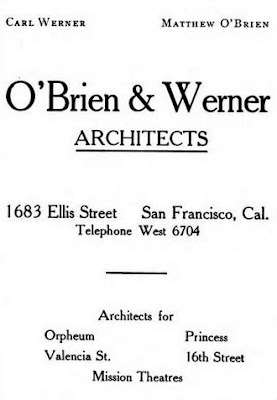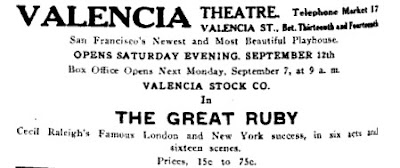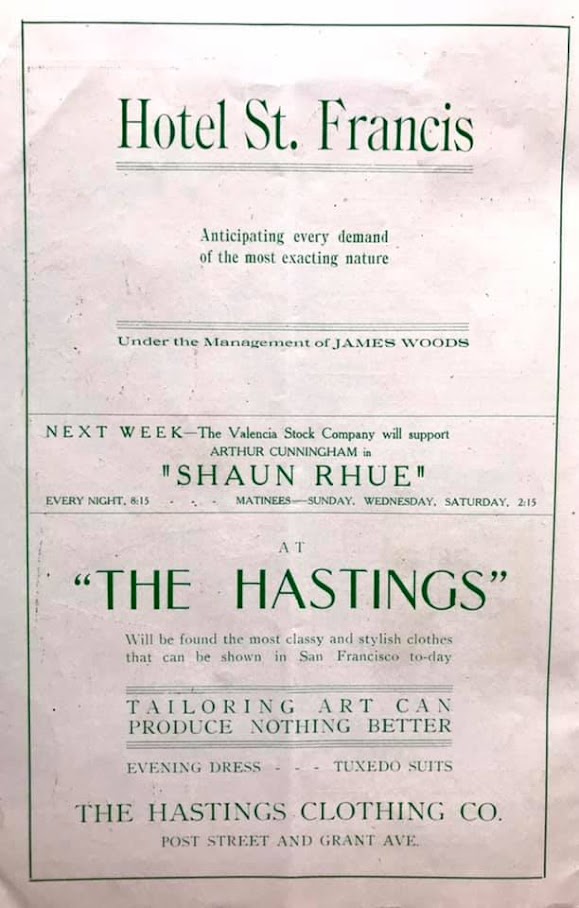251 Valencia St. | map |
Opened: September 12, 1908 as the
Valencia Theatre with
the play "The Great Ruby." Advertised as "San Francisco’s safest and
most beautiful playhouse," it was on the east side of the street between
Clinton Park St. and 14th. The construction photo by Bushnell was located by a Mr. or Miss Granola for a post on
Cinema Treasures. The Chronicle used it for an article about the new theatre that's reproduced lower on the page.
Architects: O'Brien and Werner designed the house. The building was of mostly concrete
construction with a corrugated iron roof. It was a project of J. Charles Green.
An ad for the duo that appeared on page 20 of the 1907-08 edition of
Henry's Official Western Theatrical Guide. It's on Google Books. The Orpheum they list was the one on Ellis St., later renamed the
Garrick. The
Princess was also on Ellis, next door to the Garrick. The 16th St. was later known as the
Victoria. The
Mission was on the southeast corner of Mission and 22nd and was later known as the Grand and the Realart -- no relation to the New Mission or the current Grand Theatre on Mission St.
Seating: 1,700. It was a house with a single balcony. The 1909-1910 edition of
Julius Cahn's Official Theatrical Guide
breaks down the capacity as 900 on the main floor, 200 in the front section of the balcony and 600 in the upper section, which they were calling the gallery. The Cahn guide is on Google Books.
Seating charts from a 1908 program for the play "Kerry Gow" that's in the collection of Jon Perdue. Thanks to Jon for scanning the program. The full program is reproduced at the bottom of the page.
Stage specifications:
Proscenium: 36' wide x 34' high
Stage depth: 38'
Curtain line to footlights: 3'
Flyfloor height: 24'
Paint bridge: yes
Grid height: 69'
Wall to wall: 76'
Depth under stage: 10'. There were 4 traps.
Illumination: Gas and Electric
The data comes Julius Cahn's Guide. The Valencia is also listed in the 1907-08 edition of
Henry's Official Western Theatrical Guide.
It's also on Google Books. Henry's gives a seating capacity of 1,500.
But the theatre hadn't opened at the time of publication. They note it
was under construction with a Spring 1908 opening anticipated.
An auditorium view from the collection of Jack Tillmany that appears on the
San Francisco Public Library website.
A postcard version of the auditorium photo. Thanks to Glenn Koch for sharing the card from his collection.
An article appearing in the September 5, 1912 issue of Town Talk, the Pacific Weekly. It's on
Google Books.
An ad for the Valencia from the September 12 issue of Town Talk.
This opening day article appeared in the September 12, 1908 issue of the San Francisco Chronicle. Thanks to Art Siegel for locating it.
An article about the new theatre appearing in the September 19, 1908 issue of Town Talk, the Pacific Weekly. It can be seen on
Google Books.
The theatre's opening show, "The Great Ruby," is advertised on the swing-out sign in this photo from the Jack Tillmany collection that appears
on the
San Francisco Public Library website.
A 1908 postcard version of the photo taken during the run of "The Great Ruby." It's on
Calisphere from the Museum of Performance and Design Performing Arts Library.
An article about "The Conquerors," the theatre's second production, that appeared in the the September 19, 1908 issue of Town Talk.
A
photo taken during the run of the "The Conquerors." It opened September 21, 1908. Thanks to Bob
Ristelhueber for finding this for a post on the
BAHT Facebook page. Andra Young notes
that the photo appeared in the 1909 book "The City That Is: The Story of the Rebuilding of San
Francisco in Three Years" by Rufus Steele.
An ad for "The Conquerors" from the September 19, 1908 issue of Town Talk.
Thanks to Glenn Koch for this view of the theatre from his collection. It's a card from a package of "Between the Acts Little Cigars."
The rear of the card. Thanks, Glenn!
The cover for an October 1908 program for the new theatre. Thanks to Bob Ristelhueber for finding it for a post on the
BAHT Facebook page. It's on
Calisphere from the Museum of Performance and Design Performing Arts Library.
A cover from a November 1908 program in the collection of Jon Perdue. Thanks to Jon for posting it on the page for the
San Francisco History Facebook group. The full program is reproduced at the bottom of the page.
The San Francisco Call's review, "
Kerry Gow Makes Hit at Valencia," appeared in their November 16 issue. The Call's page can be seen via the California Digital Newspaper Collection website.
The cover for the program for the December 1908 engagement of "The Lost Paradise." It's on
Calisphere from the Museum of Performance and Design Performing Arts Library.
Mrs. Fiske and her "famous Manhattan company" were at the Valencia for a run of "Salvation Nell" in June 1909. Thanks to Art Siegel for locating this item in the June 13 issue of the Chronicle.
The theatre is in the 1910 city directory as the Valencia St. Theatre.
The theatre's location as shown on page 197 of the 1913 Sanborn Fire Insurance Map. Thanks to Art Siegel for locating this in the Library of Congress collection.
A closer look at the building from the 1913 Sanborn.
The Valencia was never was a success as a legit house. By 1915 it was running films and vaudeville.
Looking south on Valencia at Duboce Avenue and Clinton Park on February 8, 1918. Thanks to Bob Ristelhueber for finding the SFMTA Photography Department & Archive photo for a post on the
BAHT Facebook page.
"Grandest, Most Beautiful of the West." We're looking north on January 24, 1919. It's a detail from a
SFMTA Photography Department & Archive photo. Thanks to Jack Tillmany for finding it in the collection and extracting this image from it.
A 1925 view by an unknown photographer appearing on the
Open SF History Project website. Thanks to Art Siegel for getting out the magnifying glass and spotting the Valencia down in the lower left. The caption: "Aerial View of South of Market from Market to Folsom, extending to the Bay.. View northeast from above Armory (bottom center), near 14th Street and Mission. In distance, from left, Civic Center, Tenderloin, Nob Hill, Telegraph Hill, waterfront, Yerba Buena Island."
A detail that Art extracted from the 1925 aerial. He dated the image as 1925 as there's no Mark Hopkins yet but the framing for the Orpheum is well along.
Closing: The theatre closed in 1926 and was sold in 1928 to get remodeled into a church.
An item about the church conversion appearing in the May 11, 1929 issue of Exhibitors Herald-World.
A 1936 San Francisco Examiner shot by Joe De Narie in the
UC Berkeley Library collection. Thanks to Paul Penna for locating it for a post for the
San Francisco Remembered Facebook group. And thanks to Art Siegel for spotting the post.
Another 1936 view from the same set. Paul Penna notes that Levi Strauss built the playground at 14th and Valencia for neighborhood kids in 1913.
The theatre shown as a Greek Orthodox Church on page 197 of the 1949 Sanborn Fire
Insurance Map. Thanks to Art Siegel for locating this in the Library of
Congress collection.
A closer look from the 1949 Sanborn. The scene shop and prop storage areas once behind the stagehouse had been demolished.
The theatre is seen as a church in the center of this detail from a 1957 photo by Bob Bryant for the San Francisco Examiner. Thanks to Art Siegel for finding this in the
Open SF History Project collection. The site's caption notes that the occasion for the photo was the fire on Duboce St. The Central Freeway, not yet completed, is seen in the upper center. The X-shaped building on the bottom edge of the image is Mary's Help Hospital. The theatre can also be seen in the lower right in
another photo from the same series.
A 1983 photo from the Max Kirkeberg Collection at
San Francisco State University. Thanks to Art Siegel for locating it. It's one of nine views they have of the building. Their caption notes that the two domes the church had added to the facade had been removed due to structural problems.
The building was heavily damaged in the 1989 Loma Prieta earthquake and
was later demolished. David Gallagher notes: "I looked at the old
permits for this and as it turns out the church had planned demolition
as early as 1988."
Demolition in progress. Thanks to Donald Harvey for this photo he took. He notes that he used to work behind the building.
A 1990 cutaway view into the stagehouse during demolition. At this point it appears that it would be difficult to get in the front doors. It's another photo that Art Siegel found from the Max Kirkeberg Collection that's on the
San Francisco State University website.
Status: Construction began in 2013 for a new church on
the site.
A 2016 Google Maps view of construction on the site.
The 1908 program for the play "Kerry Gow" from the collection of Jon Perdue:
Thanks, Jon!
More information: Jack Tillmany's Arcadia Publishing book "Theatres of San Francisco" can be previewed on Google Books. It's available from Amazon or your local bookseller.
Cinema Treasures has a page on the Valencia.
| back to top | San Francisco Theatres: by address and neighborhood | alphabetical list | list by architect | pre-1906 theatre list | home |


























































Absolutely fantastic historical information.
ReplyDeleteThanks! I'm glad you liked the page.
DeleteThere is a poster for the Ballet Russes performances at the Valencia Theatre in the little Logan book room of the Legion of Honor now. No specific date, and I took a double take, but it says 14th and Valencia. Steve
ReplyDeleteThanks. Not surprising -- they probably booked all sorts of shows before they gave up and went to movies.
Delete